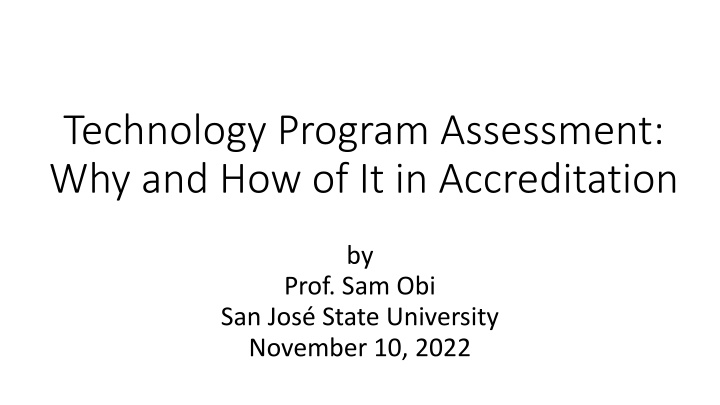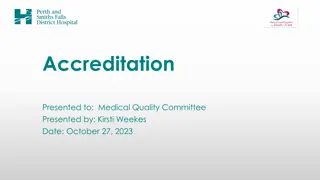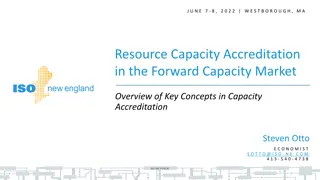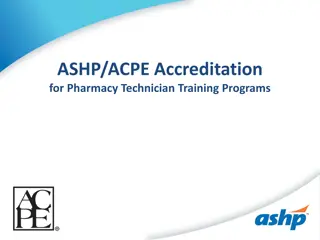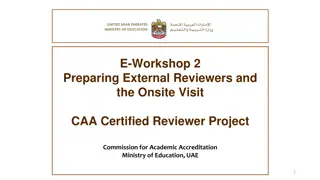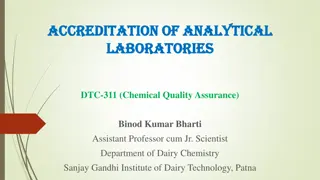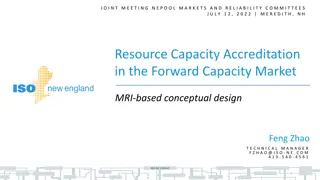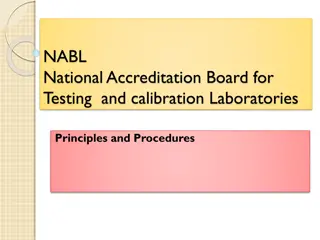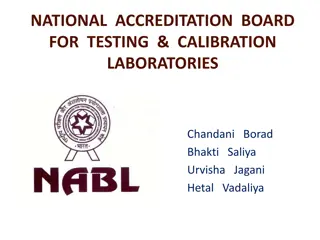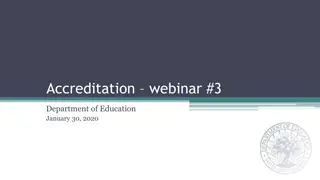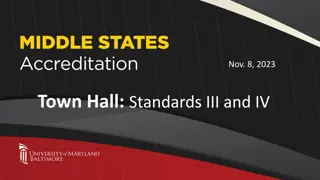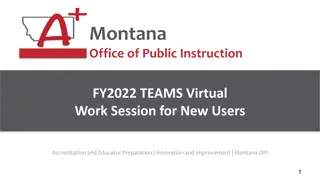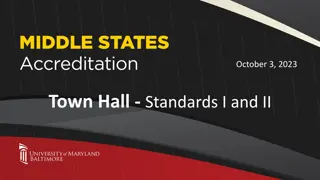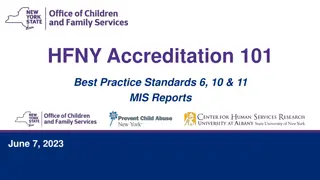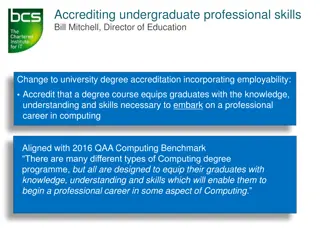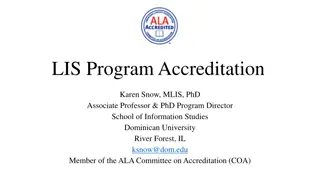Importance of Technology Program Assessment in Accreditation
Highlighting the significance of technology program assessment in accreditation, this presentation by Prof. Sam Obi at San José State University delves into the purpose, steps, and role of assessments in ATMAE accreditation. It covers the meaning and purpose of assessment, the role of assessments in ATMAE accreditation, and steps in conducting course assessment. Learn why assessment is crucial for evaluating program learning outcomes and ensuring program quality.
Download Presentation

Please find below an Image/Link to download the presentation.
The content on the website is provided AS IS for your information and personal use only. It may not be sold, licensed, or shared on other websites without obtaining consent from the author.If you encounter any issues during the download, it is possible that the publisher has removed the file from their server.
You are allowed to download the files provided on this website for personal or commercial use, subject to the condition that they are used lawfully. All files are the property of their respective owners.
The content on the website is provided AS IS for your information and personal use only. It may not be sold, licensed, or shared on other websites without obtaining consent from the author.
E N D
Presentation Transcript
Technology Program Assessment: Why and How of It in Accreditation by Prof. Sam Obi San Jos State University November 10, 2022
This presentation will focus on the following points: Purpose of Technology programs assessments The role of assessments in ATMAE accreditation Steps in conducting Technology assessments How to design assessment tools Documenting assessment tools and reports
Meaning and Purpose of Assessment Assessment means: Evaluation or estimation of the nature, quality, or ability of programs Program learning outcomes (PLOs) are used in assessments PLOs are designed by program planners PLOs are found in course syllabi PLOs should be approved by industry advisory board and faculty Purposes of assessment are: To measure how many students are learning the outcomes Those gaps or lapses provide opportunities for continuous improvement of the courses To ensure courses are addressing their design intent To ensure intended student needs are being met by courses
The Role of Assessments in ATMAE Accreditation Standard 5 - Program Learning Outcomes Identification & Validation: Measurable program learning outcomes shall be identified, assessed and validated for each program/option. These program/option learning outcomes must align with the program goals established for the program/option and validation shall be accomplished through a combination of external experts, an industrial advisory committee. Each Student Learning Outcomes (SLO s) usually seen in individual course syllabi shall be mapped to the program/option learning outcomes. After the program is in operation, follow-up studies of direct and indirect measures for each outcome Shall be conducted.
The Role of Assessments in ATMAE Accreditation Demonstrates program agility and functionality Makes accreditation process easier and less complex Makes ATMAE accreditation more genuine
Steps in Conducting Course Assessment Understand your program learning outcomes or PLO(s) Design/identify your PLO s assessment measure (assignment, quiz, project, exam etc.) Conduct the measure (give the assignment, quiz, project, exam etc.) Complete assessment tool Forward the completed assessment tool to assessment coordinator
Understand Your PLOs: CNSM PLOs 1. Demonstrate strong communication, critical thinking, and interpersonal skills 2. Use skills in team development, dynamics, and management to work as team players 3. Demonstrate ethical behavior and concern for colleagues, society, and the environment 4. Demonstrate leadership skills for a technology professional. 5. Implement and manage computer and network systems 6. Solve problems related to daily interruptions of information flow 7. Design and interface components for connected products 8. Manage databases and cloud computing systems and services 9. Implement and manage Internet of Things (IoT) systems 10.Apply cybersecurity techniques to protect networks from attacks
Understand Your PLOs: Manufacturing Systems PLOs 1. Demonstrate strong communication, critical thinking, and interpersonal skills 2. Use skills in team development, dynamics, and management to work as team players 3. Demonstrate ethical behavior and concern for colleagues, society, and the environment 4. Demonstrate leadership skills for a technology professional 5. Apply science and math principles to solve technical problems in manufacturing. 6. Integrate principles of design, materials selection, and manufacturing processes into product development 7. Implement automation, advanced and smart manufacturing including robotics, 3D printing and IIoT to improve manufacturing operations and processes. 8. Apply lean principles and quality assurance to product development, management and decision making in manufacturing enterprises 9. Demonstrate cross-functional skills to address professional practices, as well as global and societal issues relevant to manufacturing.
Steps in Conducting Course Assessment Understand your PLO(s) Map your PLOs with program s individual courses Design/identify your PLO s assessment measure (assignment, quiz, project, exam etc.) Conduct the measure (give the assignment, quiz, project, exam etc.) Complete assessment tool Forward the completed assessment tool to assessment coordinator
PLOs Mapped to Tech 31 (Quality Assurance & Control) Program Learning Outcomes (PLOs) This course is in support of the following Program Learning Outcomes: 5. Apply science and math principles to solve technical problems in manufacturing 8. Apply lean principles and quality assurance to product development, management and decision making in manufacturing Course Learning Objectives In this course, the student will: 1. Comprehend quality issues and their implications to industry and society. 2. Develop a general understanding of common quality systems employed in industry. 3. Understand basic statistical principles inherent in modern quality control systems. 4. Design appropriate quality systems to solve industrial quality problems. 5. Develop a higher responsible attitude regarding quality matters.
Steps in Conducting Course Assessment Understand your PLO(s) Map your PLOs with program s individual courses Design/identify your PLO s assessment measure (assignment, quiz, project, exam etc.) Conduct the measure (give the assignment, quiz, project, exam etc.) Complete assessment tool Forward the completed assessment tool to assessment coordinator
Design/Identify Your PLOs Assessment Measure The measure must align with the PLO(s) The measure can be an assignment, quiz, project, exam etc. The measure should be a major part of the course The measure should be designed as early as possible
Steps in Conducting Course Assessment Understand your PLO(s) Map your PLOs with program s individual courses Design/identify your PLO s assessment measure (assignment, quiz, project, exam etc.) Conduct the measure (give the assignment, quiz, project, exam etc.) Complete assessment tool Forward the completed assessment tool to assessment coordinator
Conduct the Measure Can be given at any time during the semester Instructor needs to ensure the results are not lost This is the measure that the assessment coordinator will ask for
Steps in Conducting Course Assessment Understand your PLO(s) Map your PLOs with program s individual courses Design/identify your PLO s assessment measure (assignment, quiz, project, exam etc.) Conduct the measure (give the assignment, quiz, project, exam etc.) Complete the assessment tool Forward the completed assessment tool to assessment coordinator
Complete the Assessment Tool Identify the course, semester, and year Identify the instructor Give M, E, or N to students according to their performances M = 70-86%; E = 87-100%; N < 70% Replace students names with alphabets or something else as this will become public record Send completed form to the assessment coordinator
Course Assessment form, Aviation and Technology Department Course number Title Tech 115 Automation and Robotics Instructor Name Rober werkman Student Name A B C D E F G H I J K L M N O P Q R S Semester PLOs measured 7 M E E E N M M N M M M M M M M M N M M List measures used to assess learning: How Measured Automation Group Project score 7 Implement automation, advanced and smart manufacturing including robotics, 3D printing and IIoT to improve manufacturing operations and processes. Select outcomes to be measured for semester, and score each student for each outcome: N = not met at 70% mastery M = Met (71%-89%) E = Exceeded (90%+)
Steps in Conducting Course Assessment Understand your PLO(s) Map your PLOs with program s individual courses Design/identify your PLO s assessment measure (assignment, quiz, project, exam etc.) Conduct the measure (give the assignment, quiz, project, exam etc.) Complete assessment tool Forward the completed assessment tool to assessment coordinator
Forward the Completed Assessment Tool to Assessment Coordinator The assessment coordinator collects all assessment tools from all instructors The assessment coordinator enters the data in Nuventive system Nuventive system analyzes and generates results ATMAE accreditation visiting team will see this documentation
Interpreting Assessment Data PLO 7: Implement automation, advanced and smart manufacturing Bench mark: 80% of students must score at least 70% in this 3 out of 19 students (16%) did not meet the required 70% score Conclusion: Benchmark was met. 84% of students met the criteria Action: No action needed
Interpreting Assessment Data PLO 10: Demonstrate skill in the planning and design of manufacturing Bench mark: 80% of students must score at least 70% in this 9 out of 37 (24%) did not meet the required 70% score Conclusion: Benchmark was not met. Only 76% of students met the criteria Action: Instructor to be contacted by chair of curriculum committee to address this
When a Course Does Not Meet the Benchmark* 1. The instructor is invited by the Chair or Curriculum Committee 2. The information is shared with the instructor 3. The instructor explains why it happened 4. Together, a solution (including suggestions) is discussed, designed and noted 5. The solution is implemented in the class 6. The solution is tested in the next assessment cycle *Note that not meeting assessment benchmark does not necessarily mean that the students will fail the course.
Review of Technology Programs Assessment Tools https://www.sjsu.edu/people/samuel.obi/Technology%20Courses%20R ubric%20%20SLOs%20New.xlsx
Nuventive Assessment System: Main Menu Program Summary General Program Information Program Assessment PLOs and Assessment Methods Assessment Results Annual Executive Summaries Alignment Maps Program Learning Outcome Maps Curriculum Map Reports Four Column Report with Program Information Standard Reports Ad Hoc Reports Documents and Resources Assessment Report Feedback
